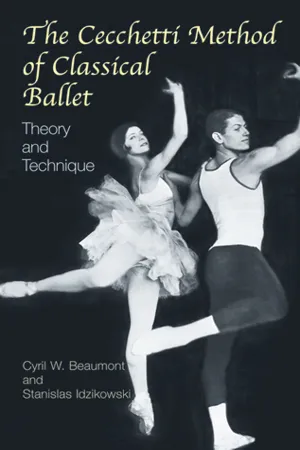
The Cecchetti Method of Classical Ballet
Theory and Technique
- 272 pages
- English
- ePUB (mobile friendly)
- Available on iOS & Android
The Cecchetti Method of Classical Ballet
Theory and Technique
About This Book
This dance classic presents a complete beginning course in classical ballet. The founder of this method, Enrico Cecchetti (1850–1928), performed and taught in Russia and with Diaghilev's troupe. By elaborating on a logical progression of exercises, Cecchetti provided dance with an unprecedented unity — balancing the adagio and allegro, re-establishing the notion of "legato, " strengthening the arabesque, and developing the exercise of the pliés. Cyril W. Beaumont, a distinguished writer on ballet, has codified Cecchetti's program of study with the assistance of one of Cecchetti's star pupils, Stanislas Idzikowski, and with the approval of Cecchetti himself.
The first chapter defines and illustrates the basic theory of the positions, body movements, and technical terms. Detailed chapters of exercises include "Exercises at the Bar, " "Port de Bras, " "Centre Practice, " "Adagio, " and "Allegro." Each exercise appears with a numbered series of instructions, and a table of daily exercises for the week is provided. The text is accompanied by 109 line illustrations, showing positions and movements of the body in detail and offering ballet lovers a perfect guide to the basics of classical ballet.
Frequently asked questions
Information
BOOK TWO
PRACTICE
PART I
EXERCICES À LA BARRE
- Pliés in the Five Positions of the Feet.
- Grands Battements à la Quatrième devant en l’air.
à la Seconde en l’air.
à la Quatrième derrière en l’air. - Battements Tendus.
- Battements Dégagés.
- Ronds de Jambe à Terre en dehors et en dedans.
- Battements Frappés sur le cou-de-pied.
- Petits Battements sur le cou-de-pied.
- Battements Relevés.
- Ronds de Jambe en l’air en dehors et en dedans.
Table of contents
- Title Page
- Dedication
- Copyright Page
- A MM. C. W. BEAUMONT ET S. IDZIKOWSKI.
- Table of Contents
- PREFACE TO THE FIRST EDITION
- PREFACE TO THE SECOND EDITION
- BOOK ONE - THEORY
- BOOK TWO - PRACTICE
- CONCLUSION.
- INDEX